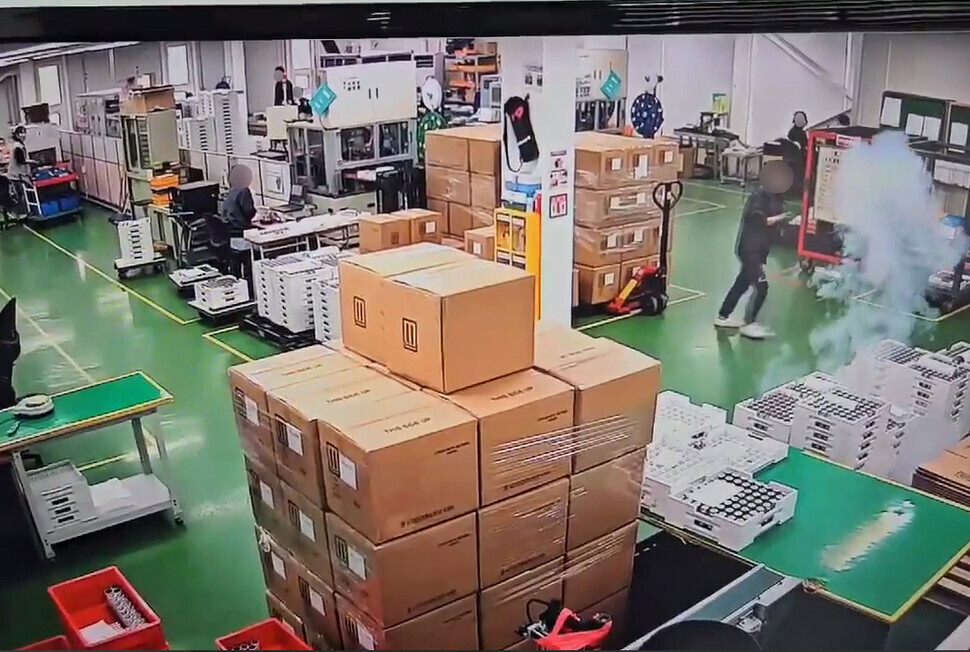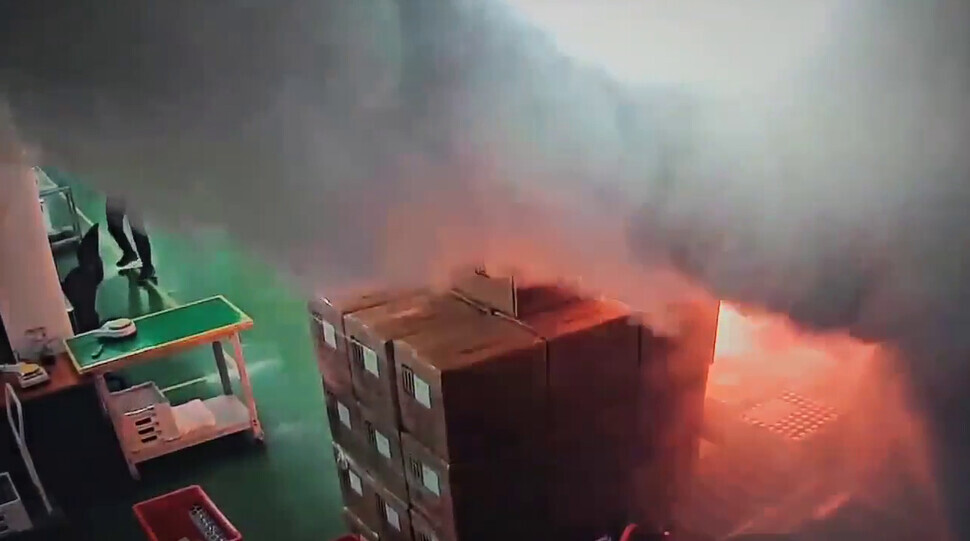hankyoreh
Links to other country sites 다른 나라 사이트 링크
Dispatched into unknown danger, foreign day laborers were defenseless against blaze

As temporary workers, they faced discrimination. As foreigners, they were ostracized. Stranded in a burning factory, the workers had no one to tell them how to escape with their lives. In a tragic error, they sought refuge from the noxious gases filling the second floor in a space with no windows or exits. As some of their luckier colleagues managed to flee from the fire and breathe sighs of relief, those who were unfamiliar with the factory took their last breaths while in a state of sheer and utter pain and panic.
The fire that broke out at a lithium battery factory in Hwaseong, Gyeonggi Province, which left 23 dead, starkly reveals a side of Korean society that we desperately want to hide. The backbone that supports this advanced, industrialized country of South Korea, are foreign workers that are considered cheap, easily replaceable, and inexpensive to manage. Such migrant workers as those lost in the fire toil in the blind spots of employment and workplace safety.
Aricell CEO Park Soon-kwan said in a press conference on Tuesday that his company “received regular safety checks and dry chemical fire extinguishers were present at the scene.” However, CCTV footage from inside the factory obtained by the Hankyoreh shows that as soon as the batteries started to explode, some workers tried to put out the fire with the fire extinguishers that were available. Their efforts were in vain, as additional battery explosions caused the flames to spread uncontrollably. This suggests that no special equipment required for the early extinguishment of lithium fires was where it should be, or that there was a lack of such equipment.
“We had fire alarms, fire extinguishers, and emergency protocol that showed how to escape easily from the building,” Park went on.

Despite such claims, the CCTV footage shows that the workers in the building seemed unaware of the gravity of the situation when the first battery started to smolder and even when the first two explosions occurred. The workers attempted to move the batteries with their hands when they began to smoke, and they didn’t cease their attempts to put out the fire even when they began to quickly explode one after the other like firecrackers. Such behavior demonstrates that the workers were not properly prepared to respond to a lithium battery fire.
“They should have gotten out of there as soon as possible when the fire couldn’t be extinguished right away, but they stayed behind and continued to try to put it out,” said Park Jae-sung, a professor of fire disaster control at Korea Soongsil Cyber University, after reviewing the CCTV footage. “To make matters worse, it seems that clutter within the workspace meant there weren’t any unobstructed paths to the emergency exit, which would have only put them at greater risk.”
The efficacy of the factory’s safety protocol and drills for disasters has also been called into question, as many of the workers were foreigners who were not guaranteed long-term employment.
After the fire, a middle manager at the factory identified as Lee said, “The company conducts fire evacuation drills once a quarter, and since we deal with lithium, a hazardous material, we always conduct safety training in advance.”
Even if we were to believe Lee’s statement, it is unlikely that day laborers and other temp workers, who are employed by dispatch work agencies and are hired on an as-needed basis, would have received frequent safety training or been privy to quarterly evacuation drills. This is because time spent on the education and training of temporary workers translates into company expenses.

Even if they had received the relevant safety training, it is common sense to assume that it would have been difficult for foreigners who were not proficient in Korean to fully grasp the disaster response procedures.
An official at a dispatch work agency that hired the workers said, “We pick people who see the advertisement for the job online, put them on the commuter bus, and send them to the Aricell factory. The conditions that Aricell asks for differ every time, so the contracts the workers are on are different every time.”
Out of the 23 workers who lost their lives in Monday’s tragedy, 17 were Chinese nationals and one Laotian national. All were temporary workers affiliated with the dispatch company. Eight of the workers were men while 15 were women.
By Lee Seung-wook, staff reporter; Lee Jung-ha, staff reporter; Key Min-do, staff reporter
Please direct questions or comments to [english@hani.co.kr]

Editorial・opinion
![[Editorial] Silence won’t save Yoon [Editorial] Silence won’t save Yoon](https://flexible.img.hani.co.kr/flexible/normal/500/300/imgdb/original/2024/0701/681719819632087.jpg) [Editorial] Silence won’t save Yoon
[Editorial] Silence won’t save Yoon![[Column] The miscalculations that started the Korean War mustn’t be repeated [Column] The miscalculations that started the Korean War mustn’t be repeated](https://flexible.img.hani.co.kr/flexible/normal/500/300/imgdb/original/2024/0630/9717197068967684.jpg) [Column] The miscalculations that started the Korean War mustn’t be repeated
[Column] The miscalculations that started the Korean War mustn’t be repeated- [Correspondent’s column] China-Europe relations tested once more by EV war
- [Correspondent’s column] Who really created the new ‘axis of evil’?
- [Editorial] Exploiting foreign domestic workers won’t solve Korea’s birth rate problem
- [Column] Kim and Putin’s new world order
- [Editorial] Workplace hazards can be prevented — why weren’t they this time?
- [Editorial] Seoul failed to use diplomacy with Moscow — now it’s resorting to threats
- [Column] Balloons, drones, wiretapping… Yongsan’s got it all!
- [Editorial] It’s time for us all to rethink our approach to North Korea
Most viewed articles
- 1Yoon’s prosecutors are throwing everything at the president’s opponents to see what’ll stick
- 2Japan is building a military meant for more than self-defense — and has the US to thank for it
- 3[Editorial] Silence won’t save Yoon
- 4NewJeans rocks Tokyo Dome as new, younger generation of K-pop fans emerges in Japan
- 5Dreams of a better life brought them to Korea — then a tragic fire tore them apart
- 6[Column] The miscalculations that started the Korean War mustn’t be repeated
- 7[Editorial] Exploiting foreign domestic workers won’t solve Korea’s birth rate problem
- 8S. Korea joins US, Japan for first multi-domain drills at a time of escalating tensions
- 9How million-strong candlelight demonstrations are being organized
- 10[Reportage] Inside N. Korean refugee protection center